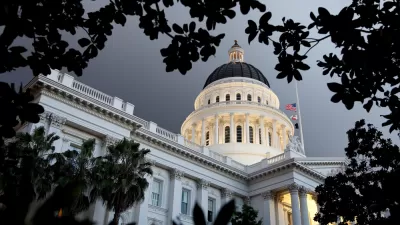In a powerful opinion in The New York Times, state Senator Scott Wiener and UC Berkeley energy professor Daniel Kammen make the case that transportation emissions are rising in the Golden States because of the shortage of housing in coastal cities.

Greenhouse gas emissions are falling in California thanks to efforts to successful policies largely targeted at electricity generation. Yet in the California Air Resources Board's last two greenhouse gas inventory reports released in 2018 and 2017, a disturbing trend has emerged: emissions from the transportation sector, by far the largest source of greenhouse gas emissions, have risen.
Senator Scott Wiener (D-San Francisco), chair of the California Senate Housing Committee, and Dr. Daniel M. Kammen, a professor of energy at the University of California, Berkeley, team-up to make a convincing case that "in order to solve the climate crisis, we have to solve the housing crisis."
In November, the California Air Resources Board [CARB] released an update on efforts to reduce pollution from transportation. The numbers were alarming. Despite headlines about California’s push for more electric vehicles, pollution from cars is still climbing. “With emissions from the transportation sector continuing to rise, California will not achieve the necessary greenhouse gas emissions reductions to meet mandates for 2030,” the board warned.
Of course, we also have to accelerate the electrification of our vehicles, another way to reduce pollution from cars. But, as the air resources board has found, electrification alone cannot happen fast enough to solve the problem, and we need to reduce the number of miles people drive by 25 percent.
Kammen's research led to the same conclusion.
In an assessment of the carbon footprint of 700 California cities, experts with the Renewable and Appropriate Energy Laboratory at the University of California, Berkeley, ... found that, for most coastal California cities, “infill” housing — that is, housing built in urban areas, near transit, jobs and services — can reduce greenhouse gas pollution more effectively than any other option. [Italics added.]
CARB and Kammen are joined by none other than the venerable United Nations Intergovernmental Panel on Climate Change (IPCC) in pointing to reducing vehicle miles traveled (VMT) as an essential strategy to reach climate targets. Their landmark special report released last October "estimates that about 20 percent of emission reductions needed to limit temperature rise need to come from trips avoided or trips shifted — from cars to trains, buses and bikes," wrote Angie Schmitt for Streetsblog USA.
"The relationship between housing and transportation emissions is not complicated," explain Kammen and Wiener. "By making housing shockingly expensive near jobs and transit, cities force low-income and working-class people to live far away from where they work."
The two authors point to the key driver of the state's increased transportation emissions – the shortage of 3.5 million homes, according to a report by the McKinsey Global Institute, resulting in an increase of super-commuters. To address that shortage, Wiener has authored the More Homes Act which "would override local restrictive zoning by legalizing small to midsize apartment buildings (up to five stories) near job centers and public transportation and set minimum affordability standards for some of those units."
Measures like the More Homes Act offer a road map to cities and states that want to address these [housing shortage] issues head-on. In fact, we’d argue that surging interest in urban housing and transportation issues, and the rise of the grass roots Yes in My Back Yard movement that’s behind it, is perhaps the most hopeful development in the American climate movement in recent years.
It remains to be seen how Wiener's bill, SB 50, fares this year. Hopefully, for the sake of the climate, it won't suffer the same fate as its predecessor.
Related in Planetizen:
-
Report: Transportation Emissions Sully California's Environmental Reputation, September 6, 2018
-
A Toolkit for Solving California's Housing Crisis, October 26, 2016
Hat tip to Dr. John Holtzclaw.
FULL STORY: Opinion: Why Housing Policy Is Climate Policy

Alabama: Trump Terminates Settlements for Black Communities Harmed By Raw Sewage
Trump deemed the landmark civil rights agreement “illegal DEI and environmental justice policy.”

Study: Maui’s Plan to Convert Vacation Rentals to Long-Term Housing Could Cause Nearly $1 Billion Economic Loss
The plan would reduce visitor accommodation by 25% resulting in 1,900 jobs lost.

Why Should We Subsidize Public Transportation?
Many public transit agencies face financial stress due to rising costs, declining fare revenue, and declining subsidies. Transit advocates must provide a strong business case for increasing public transit funding.

Wind Energy on the Rise Despite Federal Policy Reversal
The Trump administration is revoking federal support for renewable energy, but demand for new projects continues unabated.

Passengers Flock to Caltrain After Electrification
The new electric trains are running faster and more reliably, leading to strong ridership growth on the Bay Area rail system.

Texas Churches Rally Behind ‘Yes in God’s Back Yard’ Legislation
Religious leaders want the state to reduce zoning regulations to streamline leasing church-owned land to housing developers.
Urban Design for Planners 1: Software Tools
This six-course series explores essential urban design concepts using open source software and equips planners with the tools they need to participate fully in the urban design process.
Planning for Universal Design
Learn the tools for implementing Universal Design in planning regulations.
Caltrans
Smith Gee Studio
Institute for Housing and Urban Development Studies (IHS)
City of Grandview
Harvard GSD Executive Education
Toledo-Lucas County Plan Commissions
Salt Lake City
NYU Wagner Graduate School of Public Service




























